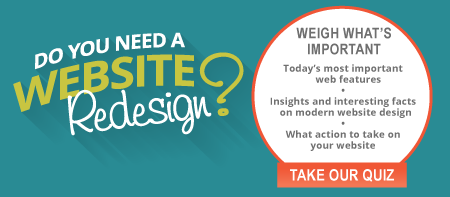
If you've noticed that some browsers are slowing down your online experiences, or if you have been frustrated with slow-loading, clunky mobile apps then you have been the victim of a bloated website and you are not alone. Average page weight has increased 15% since 2014.
As a business owner, you know that slow-loading pages are one way to lose a customer. So how do you fight this trend? You have a great opportunity to lose some page weight while undergoing a website redesign. In fact, you might want to consider a website redesign for the sole purpose of losing page weight and gaining faster loading times.
Here are four ways you can cut bloat and optimize your website redesign:
1) Get down to the basics
If you want a customer to stay on your site, then your landing page needs to load in roughly two seconds. Research shows that 47% of users expect a page to load within that narrow time frame. If you've tested your landing page's download speed and found it be less than optimal, then you need to decide where to cut back on bloat.
Images and animations are usually the first areas to direct your attention. Do you need animation? Are all the images directly relevant to your business' services and philosophy? Less is more, especially when you are trying to appeal to mobile users.
One method to start optimizing your site and limiting bloat is to break the site down to its barest essentials, however painful that may be. Then, gradually add more imagery, text, animations, different fonts, colors and backgrounds while testing for download speeds. Tools like Google's Speed Index let you know your page's download speeds. Through a series of trials, you will find a design that balances speed and content. Your users will thank you for it.
2) Clear out clutter
Remember that users spend 51% of their online time with mobile devices, not desktops. These users tend to be younger and they expect fast downloads. When it comes to site trends, younger demographics are embracing minimalist design and even brutalist design, which is defined as a stripped down site with a retro-aesthetic. Even when not on mobile devices, millennial site visitors see bloated imagery as old fashioned clutter.
Clearing out excessive animations and imagery is one way to appeal to your users' aesthetics as well as their practicality; less clutter leads to faster loading speeds.
Business-to-business users also lack the time to wait for pages to load. If they've found your landing page, you want to convert them right away, or collect information to nurture the lead. Again, less is more. Determine what will engage the user right away and what will entice them into leaving contact information. Anything more will take up too much time.
Of course, there is a place for animation and images. No one wants a bland, vanilla site. But consider re-designing your site to include images and animations on pages other than your initial landing page.
3) Clean up code
Though this technical aspect of website redesign might be out of your control, it is useful to ask your development and design team if they plan on streamlining CSS and JavaScript files. When written poorly, or if outdated, these files degrade loading times. Additionally, ask if one app can do all the work necessary to keep the page functional. At times, up to ten or more different systems operate the back-end of a page, and often this many systems are unnecessary.
4) Prepare for testing
When it comes to redesigning your website it helps to know what designs are trendy and what appeals to users. User experience experts conduct audience testing to determine what leads to higher conversions, which design elements are most appealing and how to create minimalist sites that maintain maximum engagement.
This means that the process of website design is iterative - it goes back and forth. New designs are instituted, user feedback is collected and tweaks are made until the perfect design is achieved. Though this might seem counterproductive, this kind of testing helps keep your site's loyal visitors and customers from losing interest with the site or becoming disoriented with the interface.
For more information on speeding up your load times while optimizing your website redesign, then please contact us.
Topics: Web






